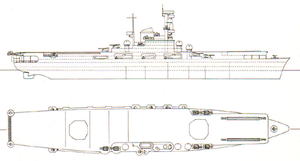German aircraft carrier II
 Line drawing of the final design | |
| Class overview | |
|---|---|
| Name: | II |
| Builders: | Arsenal de Lorient |
| Preceded by: | Jade class |
| Succeeded by: | None |
| Planned: | 1 |
| Cancelled: | 1 |
| General characteristics | |
| Type: | aircraft carrier |
| Displacement: | Design: 11,400 long tons (11,600 t) |
| Length: | 192.5 m (632 ft) |
| Beam: | 24.4 m (80 ft) |
| Draft: | 5.6 m (18 ft) |
| Propulsion: | 2-shaft Rateau-Bretagne geared turbines 10,000 shp (7,500 kW) |
| Speed: | 32 kn (59 km/h; 37 mph) |
| Range: | At 19 kn (35 km/h; 22 mph): 7,000 nmi (13,000 km; 8,100 mi) |
| Armament: | 12 × 10.5 cm (4.1 in) AA guns 12 × 37 mm (1.5 in) AA guns 24 × 20 mm (0.79 in) AA guns |
| Aircraft carried: | 12 × Ju 87C 11 × Bf 109T |
| Aviation facilities: | 1 hangar, 2 elevators |
The aircraft carrier II was a proposed conversion project for the incomplete French cruiser De Grasse. The ship was laid down in November 1938 and lay incomplete in the Arsenal de Lorient shipyard when Germany invaded France in May 1940. In 1942, Nazi Germany's Kriegsmarine decided to convert the cruiser into an auxiliary aircraft carrier with a capacity for twenty-three fighters and dive bombers. Work ceased in February 1943, however, due to concerns with the ship's design, a severe shortage of material and labor, and the threat of Allied bombing raids. The ship was eventually completed as an anti-aircraft cruiser in 1956 by the French Navy.
Design
The French cruiser De Grasse was laid down at the Arsenal de Lorient shipyard in Lorient in November 1938. Work on the unfinished ship stopped following the German conquest of France in May 1940.[1] In 1942, the Kriegsmarine considered several proposals to convert the cruiser into an auxiliary aircraft carrier. The final proposal was completed by August 1942, but work on the conversion did not last long. By February 1943, the project had been abandoned, for several reasons. The shipyard suffered from a shortage of labor and materials, and the design staff had significant concerns over the arrangement of the engine system. The Allies also posed a serious threat, as Lorient was well within the range of Allied bombers. The ship was eventually retaken by the French Navy after the end of the war, and launched in 1946.[2] She was ultimately completed in 1956 as an anti-aircraft cruiser.[1]
Characteristics
The converted ship would have been 180.4 meters (592 ft) long at the waterline and 192.5 m (632 ft) long overall. She would have had a beam of 24.4 m (80 ft) and a draft of 5.6 m (18 ft) as designed. Her designed displacement would have been 11,400 long tons (11,600 t).[3] The ship's propulsion system consisted of two sets of Rateau-Bretagne geared steam turbines, with steam supplied by four Indret ultra-high pressure boilers. The engines were rated at 10,000 shaft horsepower (7,500 kW) and would have provided a top speed of 32 knots (59 km/h; 37 mph). The carrier would have had a range of 7,000 nautical miles (13,000 km; 8,100 mi) at a cruising speed of 19 kn (35 km/h; 22 mph).[4]
As converted, the ship was to be armed with several anti-aircraft guns. The heavy anti-aircraft battery consisted of twelve 10.5 cm (4.1 in) SK C/33 guns in twin mountings.[2] The mounts were the Dopp LC/31 type, originally designed for earlier 8.8 cm (3.5 in) SK C/31 guns. The LC/31 mounting was triaxially-stabilized and capable of elevating to 80°. This enabled the guns to engage targets up to a ceiling of 12,500 m (41,000 ft). Against surface targets, the guns had a maximum range of 17,700 m (58,100 ft).[5] The guns fired fixed ammunition weighing 15.1 kg (33 lb); the guns could fire HE and HE incendiary rounds, as well as illumination shells.[6] Close-range anti-aircraft weaponry consisted of twelve 3.7 cm (1.5 in) SK C/30 guns and twenty-four 2 cm (0.79 in) Flak 38 guns.[2] The 3.7 cm gun was a single-shot gun, with a rate of fire of around 30 rounds per minute. At its maximum elevation of 85°, the gun had a ceiling of 6,800 m (22,300 ft).[7] The 2 cm gun was a magazine-fed automatic weapon, firing at up to 500 rounds per minute. Twenty and forty-round magazines were supplied for the guns;[8]
The ship's aircraft facilities consisted of a 177.5 m (582 ft) long, 24 m (79 ft) wide flight deck and two elevators. Aircraft were handled in a single hangar, which was 142 m (466 ft) long and 18.6 m (61 ft) wide. The ship's air complement was to have consisted of eleven Bf 109 fighters and twelve Ju 87 Stuka dive-bombers.[2] The Bf 109 fighters were a navalized version of the "E" model, designated as Bf 109T. Their wings were longer than the land-based model to allow for shorter take-off.[9] The Ju 87s were to have been the "E" variant, which was a navalized version of the Ju 87D, and were modified for catapult launches and were equipped with arresting gear.[10]
Notes
References
- Caldwell, Donald; Muller, Richard (2007). The Luftwaffe Over Germany: Defense of the Reich. London: MBI Publishing Company. ISBN 9781853677120.
- Campbell, John (1985). Naval Weapons of World War II. London: Conway Maritime Press. ISBN 0870214594.
- Gardiner, Robert; Chesneau, Roger (1980). Conway's All the World's Fighting Ships, 1922–1946. Annapolis, MD: Naval Institute Press. ISBN 0870219138.
- Gröner, Erich (1990). German Warships: 1815–1945. Annapolis, MD: Naval Institute Press. ISBN 0870217909.
- Kay, Antony K.; Couper, Paul (2004). Junkers Aircraft and Engines, 1913–1945. Annapolis, MD: Naval Institute Press. ISBN 0851779859.
- Schenk, Peter (2008). "German Aircraft Carrier Developments". Warship International (Toledo, Ohio: International Naval Research Organization) 45 (2): 129–158. ISSN 0043-0374. OCLC 1647131.